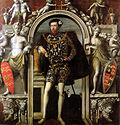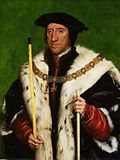Henry Howard, Earl of Surrey
Henry Howard, Earl of Surrey (1517-1547) was an English nobleman and poet.
Biography
Henry Howard was born in Hunsdon, Hertfordshire in 1517,[1] during the reign of Henry VIII. His father was Thomas Howard.[1] His mother was Elizabeth Stafford.[2] He took the title of Earl of Surrey in 1524.[1] Today he is known chiefly under that name. In 1532 he married Frances the Vere, who was fourteen years old at the time.[1] Then he became a soldier and fought in Scotland in 1542 and in France and Flanders from 1543 to 1545.[1] He was wounded in the siege of Montreuil. After he came back to England he was accused of treason, as was his father. Henry Howard was executed by beheading in the Tower of London at the age of thirty on 19 January 1547.[2] His father was sentenced to death, too. He was however saved, as the king Henry VIII died.[1] He was kept in prison for some years.[2] He was set free by queen Mary.[2]
Works
Henry Howard is known mainly for two reasons. First, he wrote sonnets.[1] He is often regarded as one of the fathers of English sonnet.[2] He introduced a new rhyme pattern for English sonnet that runs abab cdcd efef gg.[2] Today it is called Shakespearian sonnet,[3] but Surrey was first to use it. Second, he invented blank verse[1] that is unrhymed iambic pentameter.[4] This metre was later used by Thomas Kyd in drama and by John Milton in epic poems. Everyone knows blank verse from Shakespeare's works. Henry Howard used blank verse in his translations from Virgil.[5]
Henry Howard, Earl Of Surrey Media
Henry Howard, Earl of Surrey, painted by Hans Holbein between about 1541 and 1543.
Arms of Henry Howard, Earl of Surrey, KG: Quarterly of 4: 1: Gules, on a bend between six cross-crosslets fitchy argent an escutcheon or charged with a demi-lion rampant pierced through the mouth by an arrow within a double tressure flory counterflory of the first (Howard, with augmentation of honour); 2: Gules, three lions passant guardant in pale or armed and langued azure a label of three points argent (Plantagenet, arms of Thomas of Brotherton, 1st Earl of Norfolk); 3: Chequy or and azure (de Warenne, Earl of Surrey); 4: Gules, a lion rampant argent (Mowbray)
Thomas Howard, 3rd Duke of Norfolk, Henry's father
Sketch of Henry Howard, Earl of Surrey, showing a striking resemblance to his father, the Duke of Norfolk, created by Hans Holbein the Younger. C. 1530s. National Portrait Gallery
Frances de Vere, by Hans Holbein the Younger, c. 1535
References
- ↑ 1.0 1.1 1.2 1.3 1.4 1.5 1.6 1.7 "Henry Howard, Earl of Surrey - English poet". Retrieved 13 October 2016.
- ↑ 2.0 2.1 2.2 2.3 2.4 2.5 "The Life of Henry Howard, Earl of Surrey (1517-1547)". Retrieved 13 October 2016.
- ↑ "Basic Sonnet Forms". Retrieved 13 October 2016.
- ↑ Joseph Berg Esenwein, Mary Eleanor Roberts, The art of versification. Revised edition, Springfield 1921, p. 133-139.
- ↑ "Henry Howard, Earl of Surrey". Retrieved 13 October 2016.








